UniverseDataModel
This scaffolding creates, within a universe, entity instances and association instances based on a predefined template.
The entity instances generated by the scaffolding will have:
- as a display name, the display name of the corresponding navigation property, for example
Main Record; - as an identifier, the identifier of the corresponding navigation which is made of
<EntityType_Id>_<Property_Id>, for exampleDirectory_User_MainRecord.
Properties
| Property | Details |
|---|---|
| EntityType required | Type String Description Identifier of the entity type that we want to represent in the universe (as an entity instance) with all its navigations. |
| Universe required | Type String Description Identifier of the universe in which the instances to be generated are going to exist. |
Child Elements
- ExcludedProperty (optional) to ignore a given property of the specified entity type.
- RootInstance (optional) to rename the core entity instance that is to be generated, and to avoid data duplication when using several scaffoldings in one universe.
- SourceEntityType (optional) Define the source EntityType
- UniverseTemplate (optional) to use a template different from the default one.
ExcludedProperty
| Property | Details |
|---|---|
| Property required | Type String Description Property of the specified entity type that is to be ignored for the generation of entity instances and association instances. |
A scaffolding does not use filters, but a part of the entity model can be excluded with the
ExcludedProperty argument.
The following example generates a universe U8_Users based on the entity type Directory_User,
like our U1 but without the Guests property:
<Universe Identifier="U8_Users" DisplayName_L1="U8 - Users" ColumnNamesMode="Identifier" /><UniverseDataModel Universe="U8_Users" EntityType="Directory_User" >
<ExcludedProperty Property="Guests"/>
</UniverseDataModel>
When getting Usercube data in Power BI, we see the following:
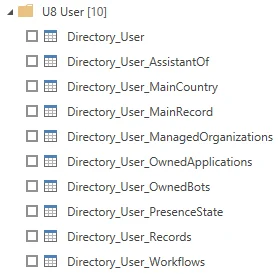
RootInstance
| Property | Details |
|---|---|
| Instance required | Type String Description Identifier of the entity instance generated based on the EntityType property of the universe scaffolding. If not specified, the identifier of the entity instance is the identifier of the entity type. |
The following example generates a universe U2_UserRecords based on the entity type
Directory_UserRecord, naming the entity instance REC:
<Universe Identifier="U2_UserRecords" DisplayName_L1="U2 - User Records" ColumnNamesMode="Identifier" /><UniverseDataModel Universe="U2_UserRecords" EntityType="Directory_UserRecord" >
<RootInstance Instance="REC" />
</UniverseDataModel>
When getting Usercube data in Power BI, we see the following:
RootInstance for several scaffoldings together
A universe can be made of several scaffoldings which need to be grouped together a specific way. One
universe made of two scaffoldings will generate the two entity instances corresponding to the two
specified entity types, with the entity and association instances corresponding to their navigation
properties. To avoid data duplication in the universe model, we use RootInstance to rename one of
the entity instances and follow the existing naming rule explained in the introduction.
The following example generates a universe U3_UserRecords based on the entity types
Directory_User and Directory_UserRecord (without RootInstance):
<Universe Identifier="U3_UserRecords" DisplayName_L1="U3 - User Records" ColumnNamesMode="Identifier" /><UniverseDataModel Universe="U3_UserRecords" EntityType="Directory_User" /><UniverseDataModel Universe="U3_UserRecords" EntityType="Directory_UserRecord" />

When getting Usercube data in Power BI, we see the following:
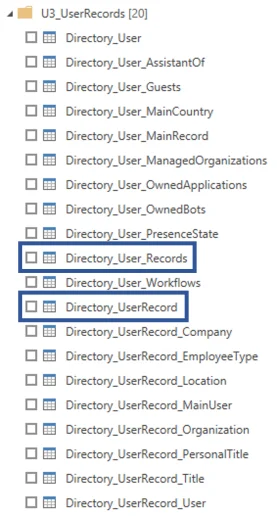
We see that Directory_User_Records and Directory_UserRecords represent the same entity
instances.
The following example generates a better version of the universe U3_UserRecords based on the
entity types Directory_User and Directory_UserRecord, renaming Directory_UserRecord as
Directory_User_Records to follow the naming rule, thus building the universe model with
Directory_User as the core entity instance:
<Universe Identifier="U3_UserRecords" DisplayName_L1="U3 - User Records" ColumnNamesMode="Identifier" /><UniverseDataModel Universe="U3_UserRecords" EntityType="Directory_User" /><UniverseDataModel Universe="U3_UserRecords" EntityType="Directory_UserRecord" >
<RootInstance Instance="Directory_User_Records" />
</UniverseDataModel>

When getting Usercube data in Power BI, we see the following:
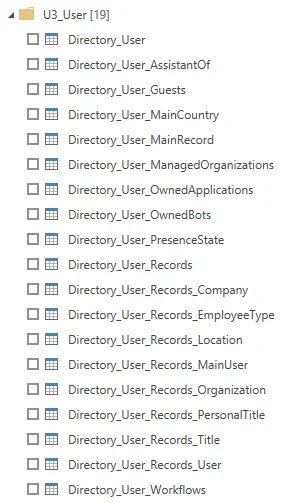
Thus we removed the duplicated data, and we understand easily the navigations of the model.
SourceEntityType
| Property | Details |
|---|---|
| Identifier optional | Type String Description The identifier's SourceEntityType |
UniverseTemplate
| Property | Details |
|---|---|
| Template required | Type String Description Represents the argument value. |
Default Template
When no template is specified, the scaffolding generates:
- an entity instance based on a given entity type;
- an association instance and an entity instance for each navigation property of the entity type.
The following example generates a universe U1_Users based on the entity type Directory_User:
<Universe Identifier="U1_Users" DisplayName_L1="U1 - Users" ColumnNamesMode="Identifier" />
<UniverseDataModel Universe="U1_Users" EntityType="Directory_User" />
It generates:
**<Universe Identifier="U1_Users" DisplayName_L1="U1 - Users" ColumnNamesMode="Identifier" >**
One entity instance for the entity type Directory_User:
<EntityInstance Identifier="Directory_User" DisplayName_L1="User" EntityType="Directory_User" />
One association instance and one entity instance per navigation property:
<AssociationInstance Association="Directory_User_MainCountry" Instance1="Directory_User" Instance2="Directory_User_MainCountry" Direction="From1To2" /> <EntityInstance Identifier="Directory_User_MainCountry" DisplayName_L1="Main Country" EntityType="Directory_Country" /> ...
**</Universe>**
When getting Usercube data in Power BI, we see the following:
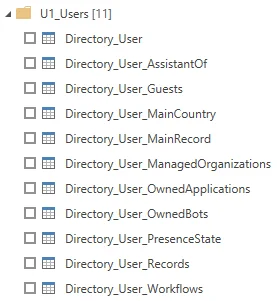
We see here identifiers instead of display names due to ColumnNamesMode set to identifiers.
OwnedResourceTypes
The following example generates a universe U4_User based on the entity type Directory_User and
the resources assigned to users:
<Universe Identifier="U4_User" DisplayName_L1="U4 - User" ColumnNamesMode="Identifier"/><UniverseDataModel Universe="U4_User" EntityType="Directory_User">
<UniverseTemplate Template="OwnedResourceTypes"/>
</UniverseDataModel>
It generates:
**<Universe Identifier="U4_User" DisplayName_L1="U4 - User" ColumnNamesMode="Identifier">**
One entity instance for the entity type Directory_User.
<EntityInstance Identifier="Directory_User" DisplayName_L1="User" EntityType="Directory_User" />
Association instances and entity instances about the AD_Entry_NominativeUser resource type:
<EntityInstance Identifier="Directory_User_OwnedAssignedResourceTypes_AD_Entry_NominativeUser" DisplayName_L1="Assigned AD User (nominative)" EntityType="AssignedResourceType" FilterProperty="RoleId" FilterResourceType="AD_Entry_NominativeUser" /> <EntityInstance Identifier="Directory_User_OwnedAssignedResourceTypes_AD_Entry_NominativeUser_Resource" DisplayName_L1="AD User (nominative)" EntityType="AD_Entry" /> <AssociationInstance Association="AssignedResourceType.Resource" Direction="From1To2" Instance1="Directory_User_OwnedAssignedResourceTypes_AD_Entry_NominativeUser" Instance2="Directory_User_OwnedAssignedResourceTypes_AD_Entry_NominativeUser_Resource" /> <AssociationInstance Association="AssignedResourceType.Owner" Direction="From2To1" Instance1="Directory_User_OwnedAssignedResourceTypes_AD_Entry_NominativeUser" Instance2="Directory_User" />
Same for all resource types.
...
**</Universe>**
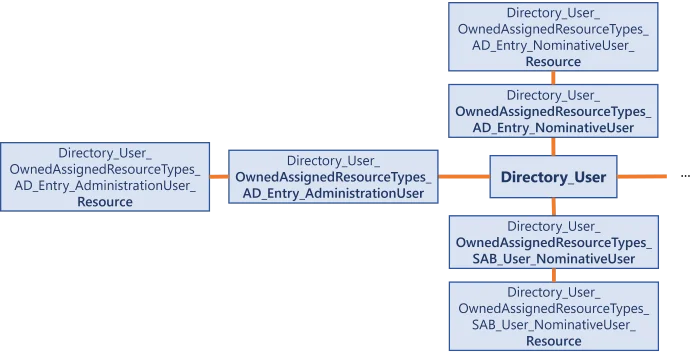
When getting Usercube data in Power BI, we see the following:
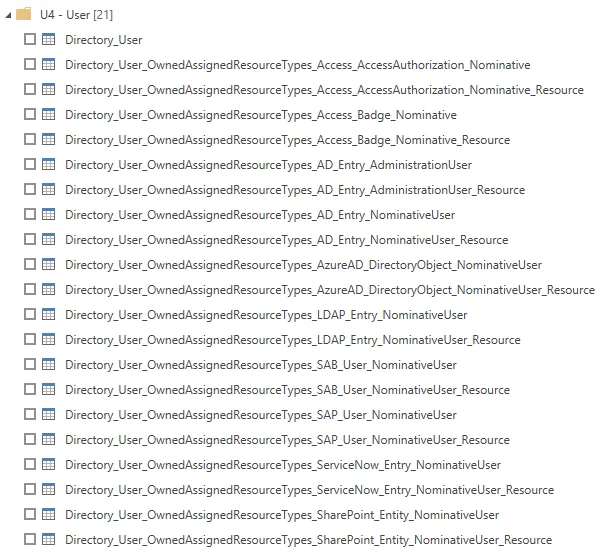
ResourceResourceTypes
The following example generates a universe U5_AD based on the entity type AD_Entry and the
owners of AD resources:
<Universe Identifier="U5_AD" DisplayName_L1="U5 AD" ColumnNamesMode="Identifier"/><UniverseDataModel Universe="U5_AD" EntityType="AD_Entry">
<UniverseTemplate Template="ResourceResourceTypes"/>
</UniverseDataModel>
The configuration generated by this snippet is similar to the one for OwnedResourceTypes.

When getting Usercube data in Power BI, we see the following:
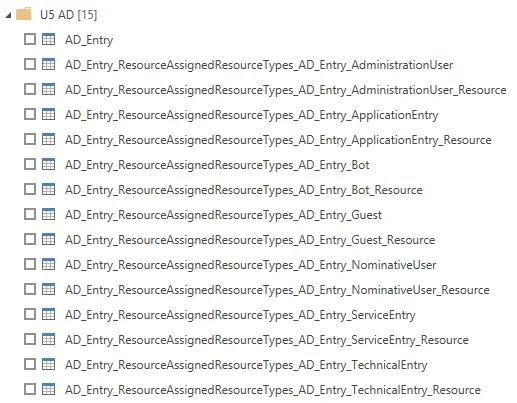
OwnedSingleRoles
The following example generates a universe U6_User based on the entity type Directory_User and
the single roles assigned to users:
<Universe Identifier="U6_User" DisplayName_L1="U6 - User" ColumnNamesMode="Identifier"/><UniverseDataModel Universe="U6_User" EntityType="Directory_User">
<UniverseTemplate Template="OwnedSingleRoles"/>
</UniverseDataModel>
It generates:
**<Universe Identifier="U6_User" DisplayName_L1="U6 - User" ColumnNamesMode="Identifier">**
One entity instance for the entity type Directory_User.
<EntityInstance Identifier="Directory_User" DisplayName_L1="User" EntityType="Directory_User" />
One entity instance containing data about role assignments, and one association instance linking it to Directory_User:
<EntityInstance Identifier="Directory_User_OwnedAssignedSingleRoles" DisplayName_L1="Assigned Composite Roles" EntityType="AssignedSingleRole" /> <AssociationInstance Association="AssignedSingleRole.Owner" Direction="From1To2" Instance1="Directory_User" Instance2="Directory_User_OwnedAssignedSingleRoles" />
One entity instance containing the single roles, and one association instance linking it to the role assignment data:
<EntityInstance Identifier="Directory_User_OwnedAssignedSingleRoles_Role" DisplayName_L1="Composite Role" EntityType="SingleRole" /> <AssociationInstance Association="AssignedSingleRole.Role" Direction="From1To2" Instance1="Directory_User_OwnedAssignedSingleRoles" Instance2="Directory_User_OwnedAssignedSingleRoles_Role" /></Universe>
When getting Usercube data in Power BI, we see the following:
OwnedCompositeRoles
The following example generates a universe U7_User based on the entity type Directory_User and
the composite roles assigned to users:
<Universe Identifier="U7_User" DisplayName_L1="U7 - User" ColumnNamesMode="Identifier"/><UniverseDataModel Universe="U7_User" EntityType="Directory_User">
<UniverseTemplate Template="OwnedCompositeRoles"/>
</UniverseDataModel>
The configuration generated by this snippet is similar to the one for OwnedSingleRoles.
When getting Usercube data in Power BI, we see the following:
Mixed Example
Scaffoldings can be adjusted with universe configuration.
The following example generates a universe U9_AccessControl aiming to create reports displaying
users and their profiles. In our situation, profiles are assigned to AD accounts based on a given
context. This is why we base our universe on the entity types AD_Entry, AssignedProfile and
ProfileContext. Plus, there are 10 dimensions in contexts, but only dimensions 0 and 1 are used,
so we exclude the others. We exclude also resource types and single roles that are of no use for us
here.
<Universe Identifier="U9_AccessControl" DisplayName_L1="U9_AccessControl" ColumnNamesMode="Identifier"> <EntityInstance EntityType="AD_Entry" Identifier="AssignedProfile_User"/></Universe><UniverseDataModel Universe="U9_AccessControl" EntityType="AssignedProfile"/><UniverseDataModel Universe="U9_AccessControl" EntityType="ProfileContext"> <RootInstance Instance="AssignedProfile_Context"/> <ExcludedProperty Property="AssignedProfiles"/> <ExcludedProperty Property="Category"/> <ExcludedProperty Property="CompositeRole"/> <ExcludedProperty Property="Dimension2"/> <ExcludedProperty Property="Dimension3"/> <ExcludedProperty Property="Dimension4"/> <ExcludedProperty Property="Dimension5"/> <ExcludedProperty Property="Dimension6"/> <ExcludedProperty Property="Dimension7"/> <ExcludedProperty Property="Dimension8"/> <ExcludedProperty Property="Dimension9"/> <ExcludedProperty Property="Dimension10"/> <ExcludedProperty Property="ResourceType"/> <ExcludedProperty Property="SingleRole"/></UniverseDataModel>
When getting Usercube data in Power BI, we see the following: